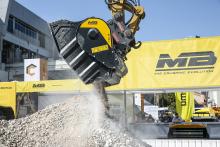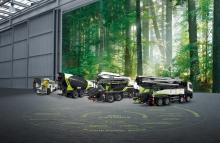However you measure success in heavy manufacturing, the highest key performance indicator has to be plant safety. Using this measure alone, Berco’s aggressive five-year lean transformation plan has had astonishing results – and its only year three. From more than 80 accidents a year, the number has tumbled to under five. The company’s 30-year old on-site ambulance was declared redundant and has been retired. It will be put into a future museum that will contain other Berco memorabilia, given that the company celebrated its 100th year last year.
Despite its heritage, Berco - part of thyssenkrupp’s business unit called Forged Technologies - had been losing market share globally since 2016-17 when it had had its best year in a decade. Its undercarriages were underperforming in the marketplace. Senior management knew they had to shift gears and do it fast. But transforming companies in the heavy manufacturing sector is traditionally not easy.
Mario Andaloni was brought into Berco from the thyssenkrupp Rothe Erde’s industrial bearing factory in Visano, in northeastern Italy, because of his work there changing the culture and manufacturing processes to improve efficiencies and productivity. But that project was much smaller, explains Andaloni, now the chief operations officer at Berco, in the small town of Copparo, near Bologna. He is in charge of a 500,000m² plant that sprawls for at least 1km in some directions and what had had a workforce of around 2,100 before the plan was started.
It is one thing to invest in better equipment and change working patterns. It is another thing to bring people along with the plan and show them that it is best for not only the company but also the employees, from senior management to shopfloor. More modern equipment and working practices would mean a better and safer working environment for the shopfloor staff but there would have to be changes in working patterns. Over the past three years, some people have left to work in other companies, some people have retired, some simply weren’t believers. Some had to be let go; an uncomfortable aspect for Andaloni. The workforce is now around 1,600.
A major part of getting the shopfloor on board with the plan was to incentivise them according to the progress. Production and efficiency targets were set with financial bonuses for attaining them along the way. To date, as the plan rolls along, all targets have been met, says Andaloni. He figures the company has completed around 63% of what it has set out to do and is on track for full completion of the five-year plan on target in mid-2023.
Before the plan, workers would remain mostly at one workstation, and whatever parts they needed was always either there – “like a supermarket” – or they could go to get it. Under the plan, with new machinery coming in, people were having to change their workstations, go to other stations, work with different colleagues and machines. It was disruption to their usual work pattern. But, says Andaloni, with much explanation and communication at all levels, the workforce came to understand that change was needed to ensure the company improved its market position, securing jobs for all. Lean manufacturing also meant that what they needed for their job would be brought to them at their workstation when needed - a just-in-time situation.
Importantly, even with more machinery and people moving about as new workstations are created, the accident level has plummeted, a testament to the logistics planning as well as the commitment of the workforce.
A complete plant layout change is underway and a walk around the site shows this transformation is a work in progress. It is a massive operation moving many machines around and selling off or scrapping outdated machinery. New machines and machines that are now in their final workstation are painted white. Others that remain to be moved are in their original orange. Some machines have had to be situated in a temporary workstation to await final placement elsewhere.
Buildings have been demolished, leaving much more open and unoccupied space around the site. Other buildings have been revamped, asbestos removed, and lighting improved. There is also much more free space within buildings. However, there are no plans to sell any sections of the site.
The pandemic, too, has had an effect on Berco’s supply chain management, especially when material and components come from China. Lean manufacturing means having on-site stock reduced to a minimum. However, in one area of Berco’s site, there is around 10% more stock from China than normally would be the case, says Andaloni. To put it mildly, he says, it has been “a difficult time” for the plant’s logistics and production schedulers. Lead time for receiving stock from China was usually 45 days. Now it is around 82. Energy cuts in China, material shortages and shipping container issues are plaguing the supply chain. Nonetheless, says Andaloni, Berco has managed to meet its customers’ orders on target thanks to forward stock planning.
The new plant layout is designed to ensure that from beginning to end there is a seamless physical flow of the products being manufactured. Before, the products were being moved around the site in a non-sequential way, back and forth from building to building, in a “snake-like movement”, says Andaloni. Lean means fewer and shorter movements of the product during manufacturing. Which is also a major element in lowering the accident rate.
Even with the plan not finished, production time for components can be five days continuous if no forging is required. Before, this was it was up to 35 days and not always continuous.
Major efficiency improvements in large-scale heating technologies means there are major savings to be gained from revamping the centralised 30-year-old-plus site heating facility. The old centralised heating system was located in “The Titanic”, as the large building was called, noting the multiple number of funnels atop the structure similar to the ill-fated trans-Atlantic steamship. Now there are only two funnels. The gas boilers used to send out water at around 85°C in large pipes snaking around the site into the buildings. At times delivery temperatures were in the 50°C range, says Andaloni, a serious energy loss. Smaller more efficient boiler systems are now located around the site closer to their final destination buildings. He estimates that the cost of the revamp is on target for being saved within only 18 months or so.
There was one central canteen with several small food shops around the site so shopfloor staff had to walk far to get a good lunch. Now, much better food is available in several new canteens that are situated so nobody walks more than 250m away from their workstation – saving valuable worker time.
Aftermarket focus
At the same time as transforming its manufacturing processes, Berco is changing tack on its presentation to the global marketplace. Heavy mining and quarrying machinery – dozers and excavators – remain an important market. But there is an added emphasis on the global construction market, and not just original equipment makers, but the aftermarket sector. To this end, over the past two years, Berco has developed three aftermarket product lines: Original, Platinum and Service.
The Original Line supplies customers with components identical to the corresponding original equipment parts, in terms of geometry and production processes. The Platinum Line exceeds this quality level, surpassing the original equipment in terms of quality, durability and performance. The Service Line was created for machines that operate in construction and offers a best value and performance balance.
To reinforce this shift is the development of a new e-commerce website for its dealers anywhere in the world. As of this month, the site is being used on a test basis by selected dealers to enable a refined offering when it is officially launched, likely in January. The website hosts the products offered Berco USA for the North American markets and Berco SpA for customers in Europe and Asia, explains Diego Buffoni, head of aftermarket at Berco. “The new e-commerce service offers comprehensive order management.”
A complete product catalogue for the undercarriage is available to dealers – currently 5,000 items are present – relating to aftermarket spare parts. Users have an advanced product search for each machine and can run searches based on the OE code or by using the Berco code. Each code is accompanied by an accurate description of the respective item, as well as images and technical details.
Berco dealers can also immediately see the stock availability of each component, its price and delivery times, current promotions and special offers. They can submit a request for a full quota. Once the order is completed and confirmed, users can follow the shipment and track their ordered goods, enabling them to adjust the warehouse processes.
R&D transformation
Part of the company transformation is a €1 million investment into a new 2,000m² research and development facility. R&D is divided into metallurgical laboratory testing and product engineering which previously were separate entities dotted around the plant. The team is currently composed of 23 researchers with an eye to adding more personnel, says Francesco Grenzi, executive director of R&D. “We are now working with generation 4.0 machines which allow us to store all of the data we collect, which can then be used for future analysis, vital for our continuous improvement.”
The standout feature the R&D department’s benchmark room where tests will be carried out on the company’s own products as well as on those of its competitors and suppliers. The revamped test bench for the company’s series of rollers is equipped with completely new software and hardware control systems that allow greater flexibility in defining load protocols. It can perform its duties without human supervision. It also allows extended period endurance tests which help Berco engineers to be more targeted in defining the applications of the rollers.
The updated rubber testing machines, moreover, are able to perform cryostatic (stable cold) tests which determine performance at very low temperatures. Rubbers are key components for the sealing of rollers, chains, idlers and track adjusters which determine product life and quality. Despite their apparent simplicity, they need to perform at very high levels in all working conditions, even at extremely low temperatures, between -40°C and -50°C.










